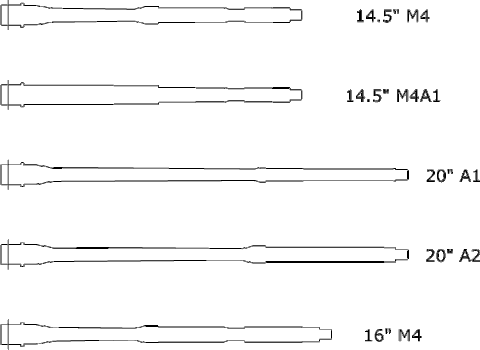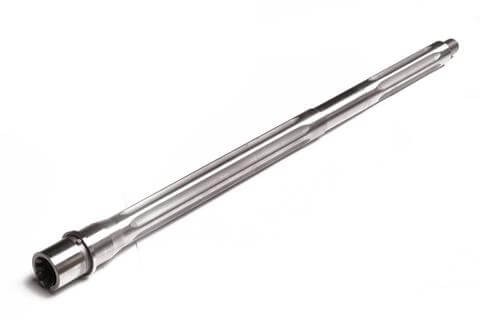
This article by Wayne Anderson is part 4 of a 5-part series about AR-15 barrels. In this article, we will cover the different AR 15 Barrel Profiles and understand the importance of fluting and dimpling in AR 15 barrels.
The rest of the series can be found at the links below:
Part 1: Intro, Fundamentals, and Manufacturing of AR Barrels
Part 2: Barrel Length, Gas Systems, and Rifling
Part 3: Caliber, Chamber, and Steel Types
Part 5: Surface Treatments and Muzzle Types
AR-15 Barrel Profiles: Explained
We’re going to get into AR-15 barrel profiles. But first, some notes from your physics class:
1) Heat is the enemy of accuracy. Shooting a rifle generates a great deal of heat, and the barrel absorbs a lot of it. As it heats, steel expands minutely, and groups on target can expand measurably. If a barrel contains unresolved stresses from manufacturing it can expand unevenly or warp, which also affects point of impact (POI) as well as group size.
A heavier barrel contains a lot more thermal mass, which means the heat can be spread into more steel, heating the barrel less overall. A cooler barrel expands less, and it remains more accurate. This is important for precision shooting – but less important for short-range or casual gunnery.
2) Weight can be your enemy or your friend, and where the weight is located matters. What’s important here is called “moment of inertia,” which is how a physicist says that it’s easier to rotate a 10 pound dumbbell in your hand than a 10 pound barbell. What matters is the distance from the mass to the force applying the rotation – which can be measured in foot-pounds, a measure of torque, or twisting force.
Two pounds at the end of a 1-foot bar exert the same 2 foot-pounds as one pound at the end of a two-foot bar. For our purposes, a gas block or muzzle brake further out on a 20″ or 24″ barrel will feel heavier than the same device on a 16″ or 14.5″ barrel. Of course, that same moment of inertia will also stabilize the rifle a little better when it’s time to squeeze the trigger.
3) Not physics but economics: When a manufacturer starts with a barrel “blank” and turns it to a specified profile on a lathe, removing more metal = more time and tooling = higher cost to you, the buyer. That’s why a lighter barrel might cost more than a heavier one — you’re not buying steel by the pound.
This matters when you remember that any barrel, no matter how slim, has to start with a blank at least the diameter of the gas block – usually either .625″ or .750″. So any part that’s narrower than that means more time on the lathe.
In the beginning, Eugene Stoner created the AR, which was upgraded to selective fire and named the M16 by the US Government.
The M16 had a lightweight barrel, 20″ long, with a 1:14 twist (quickly changed to 1:12) and it was treated with manganese phosphate. The bore was not chromed. Those lightweight barrels were actually pretty good, and helped keep the whole weapon light. Maybe it didn’t feel light to a recruit doing exercises with it, but it was a whole lot lighter than an M14 or M1 Garand.
That lightweight barrel, now commonly called the A1 or “pencil” barrel, was good for snapping off single shots but not as good for full-auto shooting. At the request of the Marines the M16A2 was given a chromed bore and a heavier barrel profile forward of the gas block, mainly to minimize the chance of bending (one of the A1’s most common failures in close combat).
This profile is now commonly called “A2”. Original-style “pencil” or “A1” barrels are still available, though usually sold with a 1:7 twist and a chromed bore.
If you’re going to be carrying a rifle for extended periods, lightweight barrels can be your friend. Besides the A1 “pencil” and A2 barrel profiles, there are two more recent significant developments: The “S2W” (strength-to-weight [ratio]) barrel, a CHF barrel by Daniel Defense, sold with a chromed bore, and the “ELW” (enhanced lightweight) profile from Bravo Company Mfg. The ELW barrel is available with fluting as an option for further lightening.
The most popular barrel profile now is the M4 style, sometimes a direct copy of the 14.5″ military M4 barrel, but more often slightly extended to 16″ for legal civilian use. The M4 barrel is lightweight under the handguards, until just before the gas port.
After the gas port it gets heavier, out to the muzzle. The additional weight really doesn’t do much as a heat sink, since most of the pressure and heat is before the gas block, but it does help a little to stabilize the rifle for offhand shooting.
On an assembled URG (upper receiver group), the M4 barrel is identifiable by the “M4 cut” – and here we’re not talking about feed ramps, but rather a narrower “notch” in the barrel, forward of the gas block, used to mount the M203 grenade launcher. While most civilians don’t have M203s, the barrels are still used to create “M4gery” rifles modeled on the military weapons.
Another profile very much like the M4 is called the “government” profile: Basically the same, but without the M4 cut. Of course, that makes it slightly heavier, but the difference is minimal.
The lightweight barrel profiles discussed above were usually designed for the common infantryman, shooting at relatively short ranges, and intended to deal reasonably well with rapid fire. Yes, lightweight barrels heat up faster, and the groups will open up, but usually we’re talking about a change on the order of 1.5-2 MOA accuracy opening up to 3 or maybe 4 MOA.
Remember, 4 minutes of angle at 100 yards is about 4 inches, and most combat shooting has been done at ranges shorter than 100 yards. The military standard is 4 MOA, and that’s pretty much good enough to hit a man-sized target at 100 yards if you take the time to aim properly.
Moving toward heavier profiles, we come back to the Special Purpose Rifle (SPR) and Designated Marksman Rifle (DMR) barrels we discussed earlier. These are usually 18 and 20 inches respectively, and made of 416 stainless steel.
Similar mission demands have otherwise made these very similar. They’re designed for slow, precise and methodical shooting – more like sniping, less like “spray and pray.”
These barrels are heavier under the handguard and taper only minutely toward the muzzle, and that mass makes them both heat and cool more slowly. What heat they do absorb affects them less, enabling them to remain acceptably accurate at extended ranges. The design is a compromise between weight for carrying and handling and muzzle velocity and heat absorption to optimize accuracy.
Next we find a profile often called “Recce” (military slang for “reconnaissance”). The Recce barrel is stainless, generally 16″ long with a mid-length gas system, and heavy under the handguard, where the extra weight does provide useful thermal mass.
This profile uses a 1:8 twist to allow 77-grain rounds, and was designed at the request of Navy SEALs who found the 18″ SPR barrel too long for their purposes but still needed a high precision (sub-MOA) combat rifle. The Navy Recce rifles have used barrels by premium custom makers like Krieger and Lilja, though other makers offer similar profiles to civilians under the Recce name.
Beyond these come the true heavyweights – the HBAR (heavy barrel) and the even heavier bull barrel profiles. These barrels are meaty, big cylinders of steel devoid of any lightening in their profiles.
They offer enough thermal mass to absorb a lot of shooting and remain rigid and accurate for a long time. While they’re generally considered pretty heavy to pack around in the field (military, hunt, or even 3-gun), they’re great for bench target shooting and long distance precision shooting.
You’ll see “varmint” barrels mentioned here and there. “Varmint” isn’t a specific profile; it’s more of a type of shooting. The theory is that you’re shooting prairie dogs and coyotes on your ranch (or similar shooting), or informal competition. The idea is long-range accuracy rather than a combat rifle. Varmint rifles tend to use very heavy barrels, usually 20-24″ long, and are generally made in stainless steel with a target crown.
It’s also worth noting that the profiles listed above aren’t the only ones available in AR barrels, just the most commonly available ones, and within those descriptions some include a number of variations. Many makers have their own preferred profiles, and some custom barrel makers will cut you a barrel in any profile you’re willing to pay for. Let’s wrap up this section with a couple of practical thoughts on barrel profiles.
1) We didn’t mention barrel “whip”; a term you’ll hear sometimes to describe barrel flexion while shooting, which obviously affects the point of impact. Of course, the more rigid barrels resist “whip” far better than the slim lightweight barrels, another reason to choose them when high accuracy is your main criterion. But there’s another way to get lightened weight without much flexion, and that’s fluting, which we’ll discuss in a moment.
2) The quick handling of single-point slings has made them the popular style on patrol in combat zones these days. But some shooters fall back on an older configuration, known to military shooters as the 1907 style sling, when precise long-range shooting is called for.
This involves disconnecting the butt end of the sling and pulling a loop into it. The shooter’s forward (usually left) arm is placed through the loop and it’s pulled tight around the biceps area. The rest of the sling, still connected to the forend of the rifle, is shortened until it applies tension between arm and rifle when the shooter relaxes. Once relaxed into the sling, the shooter adjusts his body until the rifle is on target. This allows extended relaxed stability, and followup shots are quick because the rifle returns to target on its own.
The problem, if there is one, is that a sling mount on the barrel (such as under a front sight base) applies that tension directly to the barrel when used this way, potentially creating a bit of “whip” and shifting the point of impact. The solution is to free float the barrel, and mount the sling to the free float tube, leaving the barrel untouched.
3) Some shooters choose heavy barrels for their “SHTF” (stands for “civil unrest”, trust me!) weapon of choice, imagining pouring magazine after magazine of destruction on advancing waves of ravening Nazi Klingon zombies. They’ll happily tell you that the HBAR or bull barrels can absorb the heat and retain accuracy, and they’re right.
But… how many magazines are they planning to carry? Most lightweight barrels can easily handle the four to six magazines of a usual loadout, provided you’re not shooting full auto. If the hordes of zombies are so close that you’re dumping magazines at them, an increase from 2 to 3 MOA accuracy won’t substantially affect your hits, and you’d be far better off taking carefully placed head shots anyway.
In a survival scenario it’s more likely that your rifle will spend most of its time slung on your back, where the lighter weapon will produce less fatigue, and will be used only occasionally. When it is used, the light barrel will probably easily handle as much ammo as you can comfortably carry.
In summary: Lighter barrels are less fatiguing to carry; longer barrels are good for long-range shooting, and heavy barrels are best for bench shooting or extremely long range. There’s a reason most service personnel opt for the light M4 for general patrol work. A fatigued gunner is a less accurate and less useful gunner.
All About Fluting & Dimpling
Fluted barrels are simple in concept, but seem to be the source of a lot of misunderstanding and controversy. Some people will tell you that fluting makes a barrel stronger or more rigid. Some will tell you it improves barrel cooling. Everyone agrees that it makes them lighter.
Simply put, a fluted barrel is one that has had material removed from the outer surface, generally in grooves that run lengthwise along part of the barrel. AR barrels can be fluted before or after the gas block, but the gas port area itself is never fluted, due to the need for a full diameter at that point.
Let’s dispel a myth right here: Fluting a barrel does NOT make it stronger, nor does it make it more rigid. You can’t achieve either of those things by removing material. What you can do is improve the ratio of strength to weight by carefully removing material in selected areas.
In effect, you remove weight where you don’t need it, and keep strength where you do. The result is that, when done right, a fluted barrel will be stronger in certain areas, and more rigid in certain axes, than an unfluted barrel of the same weight.
Fluting also increases the barrel’s surface area, which means that there’s more exposure to cooling air – in effect, the sides of the flutes act a little like cooling fins. Some people will tell you it’s significant, others will say the additional cooling is almost too little to measure.
The fact is that a great deal depends on the depth and width of the flutes, since deeper flutes create more surface area. Of course, a barrel that’s fluted too deeply loses critical strength to contain the immense pressures, and it’s possible to flute a barrel deeply enough that it bursts. (There’s a photo circulating of a fluted Barrett .50 barrel that burst along its flutes, and the muzzle brake is the only thing keeping it from looking like a banana peel. In Barrett’s defense, they didn’t sell it that way; it was fluted by an aftermarket gunsmith.)
There’s another thing to think about — the barrel’s mass acts as a heat sink. Fluting increases cooling surface area, but also removes thermal mass, so the cooling gains are at least partly offset by lost thermal mass. On the other hand, fluting can relieve manufacturing stresses in the steel.
So not all flutes are created equal – shallow ones retain more strength, deeper ones help with cooling.
Some people like flutes because they look cool. This leads to decorative embellishments like spiral fluting, or, further yet, diamond fluting, created by cutting spiral flutes first clockwise around the barrel, then counterclockwise. There’s also “dimpling,” machining a series of dimples along the barrel’s surface, making it reminiscent of a golf ball. It’s been said that dimpling produces better thermal efficiency in shedding heat; of course, that would also depend on depth and surface area.
There’s one more point of fluting worth mentioning: Bravo Company’s ELW (enhanced lightweight) barrel begins with a gracefully tapered profile, which allocates mass and strength along the barrel’s axis appropriate to the pressure loads. This barrel is also offered with straight flutes, which begin near the chamber, cut deep, but as the profile tapers the flutes become shallower until they end entirely. This makes an elegant and beautiful solution to optimizing the barrel; it’s a pity that most of it will be covered by a handguard.
One Last Tip
If there’s anyone that knows the AR-15 platform, it’s the US military. As a special offer for our readers, you can get the Official US Army Manual for AR-15/M4/M16 right now – for free. Click here to snag a copy.






As I said earlier in another comment most of my decisions about how to build my AR rifle will be based on how to reduce felt recoil. On the other hand a nice heavy barrel made of the strongest (toughest?) steel possible and with fluting the length of the portion before the gas port sounds really cool, pun intended. I’ve pretty much decided on a 20″ barrel and will have a flash hider rather than a muzzle brake as my ears are already going.
I see “SOCOM” mentioned alot as a barrel type. Which of your classifications would that be under?
Wow, this article was tremendously helpful on understanding the design significance of barrels. I learned many things reading things that gives much new enlightenment. Thank you.
Very informative, thanks for the great article.
What about hanson barrels?
Great article. A nice and tidy overview of AR barrels, and without a lot of nonsense. Thanks!
Really informative summary. Just what I needed!
Great article on AR-Barrels. I learned so much on the type of barrel I’m looking for to upgrade my AR platform .
Thanks so much